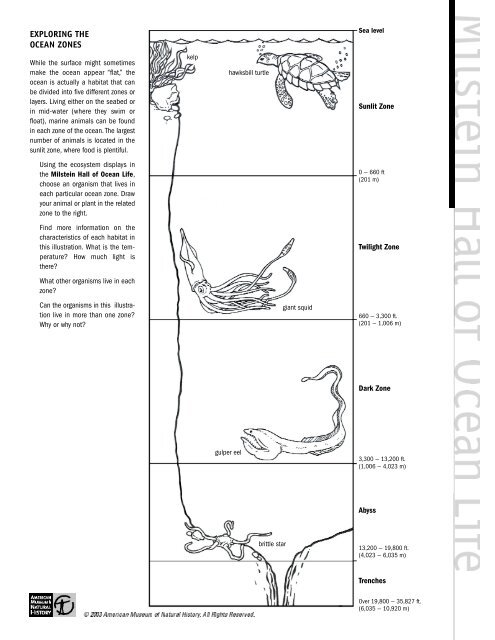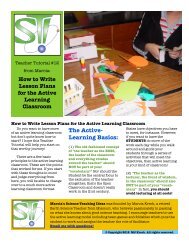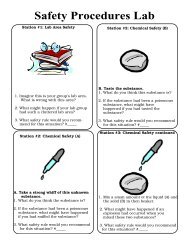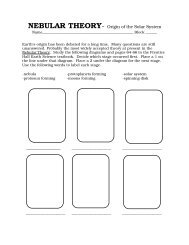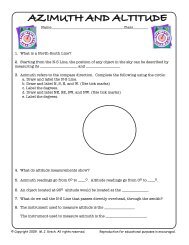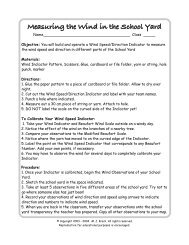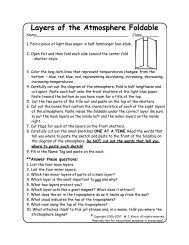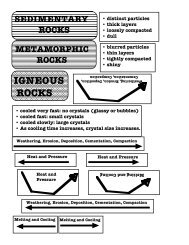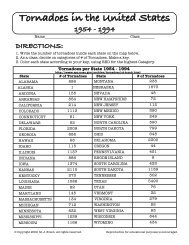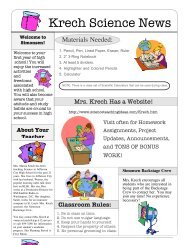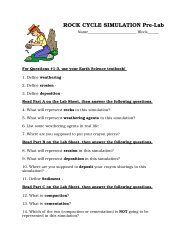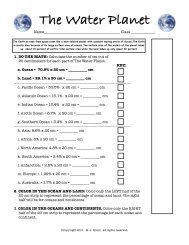EXPLORING THE OCEAN ZONES
EXPLORING THE OCEAN ZONES
EXPLORING THE OCEAN ZONES
- No tags were found...
Create successful ePaper yourself
Turn your PDF publications into a flip-book with our unique Google optimized e-Paper software.
Get your toes wet! Discover just a few of the manyamazing facts about the ocean and ocean life. Use thequestions below as springboards to help expand what youknow about the remarkable ocean.The great blue whale, Balaenoptera musculus,is the largest known animal ever to have livedon the sea or land. One blue whale can weighnearly 200 tons – more than the weight of 28adult elephants! As powerful as they are, theseanimals would be helpless on land. Why isthat?The t i n i e s t sea creatures are the microscopicp l a n k t o n. They form the basis of the ocean foodweb on which all higher animals depend. How arethese tiny organisms connected to the largestorganisms in the ocean—and even to us?Green turtles can migrate more than 1,400 milesto lay their eggs. Why do they need to laytheir eggs on land?Tuna are the fastest swimming fish in the ocean.An adult bluefin tuna can swim up to 55 miles perhour. What features of the tuna’s body helps itachieve this speed? Think of other “fastthings” you may have seen.The seahorse can change its color to camouflageitself, as well to communicate to other seahorses.What role does the male seahorse playin developing young seahorses?Penguins “f ly” underwater at up to 25 miles perhour. What special swimming technique allowspenguins to move so quickly?Algae produce over half of the oxygen that webreathe. What effect can global warming haveon algae?Horseshoe crabs have existed in essentially thesame form for the past 135 million years. Why doyou think its evolved form has been so successful?Substances from seaweed are used in photographicfilm, cotton thread, medicines, paint,face creams, soup, and ice cream. What other“ingredients” from the ocean are in items youuse all the time?A group of herring is called a siege. A group ofjellyfish is called a smack. What is a group ofdolphins called?Giant kelp are the fastest growing plants in theworld. In warm water, they can grow up to 2 feetin one day. Why would kelp need feet? (Hint:This is a trick question!)At the deepest point in the ocean the pressure ismore than 8 tons per square inch. That’s the sameas one person trying to support 50 jumbo jets!What would happen if a person went unprotectedto the deepest point of the ocean?If extracted, all the gold suspended in theocean’s water would give each person on Earth 9pounds. How much gold would that be?If the ocean’s total salt content were dried, itwould cover the continents to a depth of 5 feet.Why is there so much salt in seawater?Sound travels five times faster in water than inair. How do some aquatic animals take advantageof this fact?WEB-OF-LIFE GAME1. On index cards, write the names of organisms from the Kelp Forests ecosystem (see the opposite side of this insert).2. Ask students to sit in a circle and take one card each.3. Toss a ball of string to one student, who reads aloud the name on his or her card.4. While holding the end of the string, the student tosses the ball to another student.5. The second student reads out the name on his or her card and explains how it might relate to the previous card.Suggestions and discussions can follow. (Use photographs with younger students.)6. The second student holds the string tightly and tosses the ball to a third student. The process is repeated until allstudents have participated.7. The web created by the string illustrates the complex ecology of the continental shelf ecosystem. Have studentspredict and discuss what might happen to the web if certain items are removed or become extinct.© 2003 American Museum of Natural History. All Rights Reserved.
WEB-OF-LIFE GAMEThe organisms pictured below are from the Kelp Forests ecosystemdisplay in the Milstein Family Hall of Ocean Life. Use the plants andanimals pictured here for the Web-of-Life game. (Directions are on theopposite side of this insert.) The pictures can be photocopied and cutinto cards, or the names of the organisms can be copied onto cards.Find these organisms in the Kelp Forests display in the Hall. Examinethe characters – shape, color, size, patterns, texture, scales, feathers,roots – of the different animals and plants. What do these tell youabout:if and how the organism moves?what the organism eats?how the organism protects itself?


